Class 10 Science: CBSE Sample Question Paper (2019-20) - 1 | Science Class 10 PDF Download
Class-X
Science-086
SAMPLE QUESTION PAPER 2019-20
TIME: 3 Hrs.
M.M: 80
General Instructions:
1. The question paper comprises three sections - A, B and C. Attempt all the sections.
2. All questions are compulsory.
3. Internal choice is given in each section.
4. All questions in Section A are one - mark questions comprising MCQ, VSA type and
assertion-reason type questions. They are to be answered in one word or in one sentence.
5. All questions in Section B are three - mark, short - answer type questions. These are to be answered in about 50 - 60 words each.
6. All questions in Section C are five - mark, long - answer type questions. These are to be answered in about 80 - 90 words each.
7. This question paper consists of a total of 30 questions.
SECTION A
Q.1. The flow of energy is unidirectional. On the basis of the statement given, what information is obtained from the energy flow diagrams? (1 Mark)
Ans: The amount of energy being transferred from the lower trophic level to the higher one, is about 10 % . This energy is not reverted back to its source or to the previous trophic level.
Q.2. The resistance of an electric bulb drawing 1.2 A current at 6.0 V will be: (1 Mark)
(a) 0.5 Ω
(b) 5 Ω
(c) 0.2 Ω
(d) 2 Ω
Ans: (b)
Resistance of bulb 
Q.3. Answer question numbers 3(a) -3(d) on the basis of your understanding of the following paragraph and the related studied concepts.
"Renewable energy sources such as wind energy are vital for the Indian economy, not only from the point of view of supply, but also from the perspective of environmental and social benefits. India is the world's fifth largest wind-power producer and the largest windmill facilities in India are installed ,in Tamil Nadu. Muppandal is a small village of Tamil Nadu and one of the most important sites of wind-farm in the state. It uses wind from the Arabian Sea to produce renewable energy. The suitability of Muppandal as a site for wind farms stems from its geographical location as it has access to the seasonal monsoon winds.
The electrical generators used on wind turbines in sites like Muppandal, produce an output AC of 240 V and a frequency of 50 Hz even when the wind speed is fluctuating. A transformer may be required to increase or decrease the voltage so it is compatible with the end usage, distribution or transmission voltage, depending on the type of interconnection".
(a) State the principle behind electric generator. (1 Mark)
(b) The output frequency of wind turbine is 50 Hz. What is meant by this statement? (1 Mark)
(c) Why do you think Muppandal is at an advantageous position for this project? (1 Mark)
(d) Based on the data represented in the graph below, which of the two cities A or B would be an ideal location for establishing a wind-farm and why? (1 Mark)
Ans: (a) The principle behind electric generator is Electromagnetic Induction- the phenomenon of producing current in a coil by changing the magnetic field associated with it.
(b) The polarity of the output alternating current changes every 1/100 seconds.
Alternately : In 1 second the output (AC) completes 50 cycles.
(c) The suitability of Muppandal as a site for wind farms stems from its geographical location as it has access to the seasonal monsoon winds;
(d) City A
It is more suitable for a wind-farm as there is consistently high wind-speed in that city throughout the year.
Q.4. Using the given part of the periodic table, answer the following questions:

(a) Name the element having smallest atomic size. (1 Mark)
(b) Write electronic configuration of elements E. (1 Mark)
(c) Identify the elements which have similar physical and chemical properties as the element Y. (1 Mark)
(d) The number of groups the modern periodic table has (1 Mark)
(i) Seven
(ii) Eight
(iii) Seventeen
(iv) Eighteen
Ans: (a) Element : E
(c) X and Z.
(d) There are 18 columns known as group that the modern periodic table has.
Q.5. Which of the following is not a combination reaction? (1 Mark)
(a) Fe + S → FeS
(b) CaO + CO2 → CaCO3
(c) NH3 + HCI → NH4CI
(d) AgNO3 + NaCI → AgCI + NaNO3
Ans: (d)
AgNO3 + NaCI → AgCI + NaNO3 is not a combination reaction. It is double displacement reaction because in this reaction, exchange of ions takes place.
Q.6. NaOH on adding blue litmus solution and methyl orange indicator changes colour respectively to (1 Mark)
(a) blue, yellow
(b) blue, pink
(c) yellow, pink
(d) colourless, blue
Ans: (a)
blue, yellow
Q.7. Unit of electric power may also be expressed as: (1 Mark)
(a) volt-ampere
(b) kilowatt-hour
(c) watt-second
(d) joule-second
Ans: (i)
volt-ampere
Power = Voltage x Current.
Q.8. In a synapse, chemical signal is transmitted from: (1 Mark)
(a) dendritic end of one neuron to axonal end of another neuron.
(b) axon to cell body of the same neuron.
(c) cell body to axonal end of the same neuron.
(d) axonal end of one neuron to dendritic end of another neuron.
Ans: (d)
Synapse is a microscopic gap between two neurons where chemical signal is transmitted from axonal end of one neuron to dendritic end of another neuron.
Q.9. During photosynthesis, the function of chlorophyll is (1 Mark)
(a) to reduce carbon dioxide
(b) to breakdown water molecule
(c) to absorb light energy
(d) None of these
Or
Which one of the following is not related to the function of kidney?
(a) Blood pressure regulation
(b) Blood filtration
(c) Ions concentration regulation
(d) Antibodies secretion
Ans: (c)
Light energy is absorbed by chlorophyll present in leaves. The events which occur during photosynthesis are absorption of light energy by chlorophyll, conversion of light energy to chemical energy, splitting of water molecules into hydrogen and oxygen and finally, the reduction of carbon dioxide to carbohydrates.
Or
The regulation of blood pressure, blood filtration and ions concentration regulation are the functions of kidneys. However, secretion of antibodies is not a function of the kidneys.
Q.10. In our country, there are attempts to increase the height of several existing dams like Tehri and Atmati dams across Narmada. Choose the correct statements among the following that are a consequence of raising the height of dams. (1 Mark)
(i) Terrestrial flora and fauna of the area is destroyed completely.
(ii) Dislocation of people and domestic animals living in the area.
(iii) Valuable agricultural land may be permanently lost.
(iv) It will generate permanent employment for people.
(a) (i) and (ii)
(b) (i), (ii) and (iii)
(c) (ii) and (iv)
(d) (i), (iii) and (iv)
Ans: (b)
Statements (i), (ii) and (iii) are correct.
Q.11. Identify the basic salt from the following salts: (1 Mark)
(a) Na2CO3
(b) NH4Cl
(c) NaNO3
(d) KCl
Ans: (a)
Na2CO3
Q.12. Electrical resistivity of a given metallic wire depends upon: (1 Mark)
(a) its length.
(b) its thickness.
(c) its shape.
(d) nature of the material.
Ans: (d)

Electrical resistivity of a given metallic wire depends on the number density of free electrons in the conductor which is the nature of the material. Resistivity of material does not depend on length, thickness, and shape of the material.
Q.13. In each of the following questions, a statement of Assertion is given by the corresponding statement of Reason. Of the statements, mark the correct answer as (1 Mark)
(a) If both Assertion and Reason are true and Reason is the correct explanation of Assertion.
(b) If both Assertion and Reason are true, but Reason is not the correct explanation of Assertion.
(c) If Assertion is true, but Reason is false.
(d) If Assertion is false, but Reason is true.
Assertion In myopia, a person can see distant objects clearly but cannot see nearby objects clearly.
Reason Myopia can be corrected by using concave lens.
Ans: (d)
In myopia, a person can see nearby objects clearly but cannot see distant objects clearly. Myopia can be corrected by using concave lens. Hence, Assertion and Reason both are false.
Q.14. Alkali metals are hard and cannot be cut with a knife. (1 Mark)
Ans: False
SECTION B
Q.15. (i) Write two observations when lead nitrate is heated in a test tube.
(ii) Name the type of reaction.
(iii) Write a balanced chemical equation to represent the above reaction. (3 Mark)
Ans: (i) It turns yellow due to formation of lead oxide and Reddish brown fumes evolve.
(ii) Thermal decomposition reaction.
(iii) 
Q.16. Explain the following: (3 Mark)
(a) Sodium chloride is an ionic compound which does not conduct electricity in solid state, whereas it does conduct electricity in molten state as well as in aqueous solution.
(b) Reactivity of aluminium decrease if it is dipped in nitric acid.
(c) Metals like calcium and magnesium are never found in their free state in nature.
Ans:(a) In molten state, due to heat the electrostatic force of attraction between the oppositely charged ions overcome. So, ions move freely and conduct electricity.
In aqueous solutions, ions are free and conduct electricity whereas, in solid state, ions are fixed in position and so there are no free electrons present to conduct electricity.
(b) Due to the formation of a coating of aluminium oxide/Al2O3.
(c) Reactive metals like calcium and magnesium react easily with different elements and occur in the form of ores.
Q.17. 'The timing and amount of hormone released are regulated by feedback mechanisms'. Derive your own conclusions from the statement given above and prove your point by giving an example. (3 Mark)
Ans: Regulation of the amount and timing of hormonal secretion is controlled by a mechanism called the feedback mechanism, in this, the product or output of a process acts as the regulator of the process, through which it is obtained, e.g. increased blood sugar level is detected by the p-cells of pancreas, which respond by producing more insulin. A fall in the blood glucose level stimulates the pancreatic p-ceils to stop insulin secretion.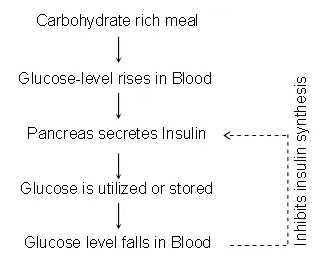 Fig: Feedback Control of Blood Glucose LevelQ.18. Why is biogas considered an excellent fuel? (3 Mark)
Fig: Feedback Control of Blood Glucose LevelQ.18. Why is biogas considered an excellent fuel? (3 Mark)
Ans: Biogas is considered an excellent fuel because it is odourless, bums without smoke and does not produce any ash. Moreover, its calorific value is quite high.
Q.19. Explain the processes of aerobic respiration in mitochondria of a cell and anaerobic respiration in yeast and muscle with the help of word equations. (3 Mark)
Ans: 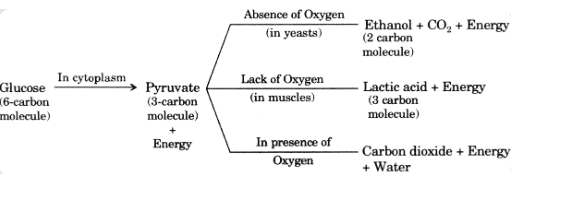
Q.20. A student holding a mirror in his hand, directed the reflecting surface of the mirror towards the Sun. He then directed the reflected light on to a sheet of paper held close to the mirror. (3 Mark)
(a) What should he do to burn the paper?
(b) Which type of mirror does he have?
(c) Will he be able to determine the approximate value of focal length of this mirror from this activity? Give reason and draw ray diagram to justify your answer in this case.
OR
A 10 cm tall object is placed perpendicular to the principal axis of a convex lens of focal length 12 cm. The distance of the object from the lens is 18 cm. Find the nature, position and size of the image formed.
Ans: (a) Move the mirror/paper to focus the rays at one point.
(b) Concave mirror.
(c) Yes, distance between mirror and focal point gives approximate focal length.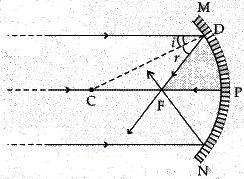
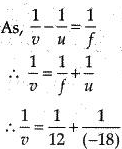
v = 36 cm (Distance of the image)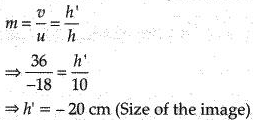
Nature of image - Real and inverted.
Q.21. (i) Why fertilisation is only possible, if copulation takes place during the middle of menstrual cycle? Also, name the process which gets temporarily stopped, when a woman gets pregnant.
(ii) Prenatal sex-determination has been banned in India, Comment. (3 Mark)
Ans: (i) As ovulation occurs on the 14th day of the menstrual cycle, sperm s have greater chances during this period to fertilise the egg or ovum.
After fertilisation, the process of menstruation does not occur as during pregnancy the thick uterine wall, which would get sloughed off during the menstrual cycle, is now being used for nourishment, growth and development of fertilised ovum.
(ii) The male-female sex ratio is rapidly declining in the Indian society due to the practise of female foeticide. Thus, to avoid this, prenatal sex-determination has been banned in India.
Q.22. What is a rainbow? Draw a labelled diagram to show the formation of a rainbow. (3 Mark)
Ans: Rainbow is a natural spectrum formed in the sky after a rain shower. Rainbow is caused by dispersion of sunlight by tiny water droplets hanging in the atmosphere after a rain shower. The water droplets act like small prisms. The water droplets refract and disperse the incident sunlight. These rays are then reflected internally and finally refracted again and come out of rain drop. Due to the dispersion and internal reflection of light different colours reach the observer’s eye and rainbow is seen.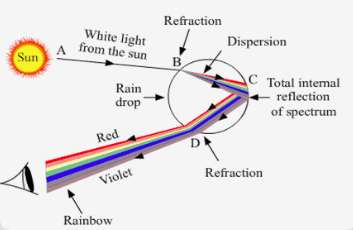 An important point to be noted here is that a rainbow is always formed in a direction opposite to that of Sun.
An important point to be noted here is that a rainbow is always formed in a direction opposite to that of Sun.
Q.23. Suppose your parents have constructed a two room house and you want that in the living room there should be a provision of one electric bulb, one electric fan, a refrigerator and a plug point for appliances of power up to 2 kilowatt. Draw a circuit diagram showing electric fuse and earthing as safety devices. (3 Mark)
Ans: (i) Four components should be labelled.
(ii) All of them should be in parallel and there should be a fuse for safety.
(iii) Live and earth wires should be there.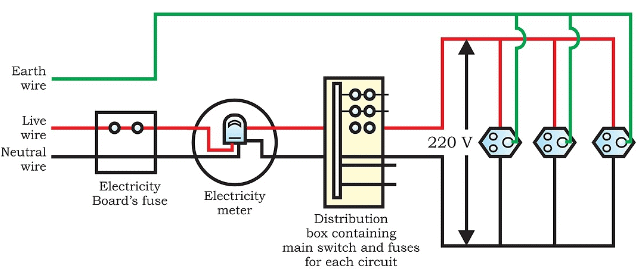 Fig: Domestic Electric Circuit
Fig: Domestic Electric Circuit
Q.24. You have been selected to talk on "Ozone layer and its protection" in the school assembly on 'Environment Day'. (3 Mark)
(a) Why should ozone layer be protected to save the environment ?
(b) List any two ways that you would stress in your talk to bring in awareness amongst your fellow friends that would also help in protection of ozone layer as well as the environment.
Ans: (a) Because Ozone layer protects/shields the Earth from harmful UV radiations of the Sun.
(b) (i) Conducting poster making competition highlighting effects of ozone layer depletion.
(ii) Conducting street plays highlighting the ways of environment protection.
SECTION C
Q.25. Number of vultures are decreasing remarkably now-a-days, which is a matter of concern. (5 Mark)
Answer the following questions related to the above given statement.
(i) Vultures belong to which category of animals?
(ii) What is their role in nature to maintain ecological balance?
(iii) At which trophic level will you place vultures, in a food chain?
(iv) How much energy is passed on at each trophic level in a food chain? Give the energy flow diagram of an ecosystem.
(v) Mention one of the main cause for this decline in the number of vultures.
Or
'Ozone at higher levels of the atmosphere is a product of UV radiation acting on oxygen molecules. However, same UV radiation is responsible for ozone layer depletion when CFCs act on it.' Comment.
Ans: (i) Vultures are scavengers, which feed on dead and decaying matter.
(ii) They help in maintaining ecological balance by recycling nutrients and clean the nature by eating dead animals.
(iii) Vultures are always placed at the highest trophic level in a food chain, i.e., they are tertiary consumers.
(iv) 10% of the total energy is passed on at each trophic level. Rest of the energy is either lost as heat to the environment or it goes into various metabolic processes.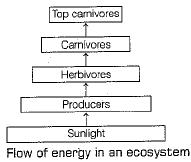
(v) The accumulation of a non-biodegradable compound (diclofenac) leads to the thinning of egg shells of the bird eggs. This kills the unhatched young ones and is responsible for decline the number of vultures.
Or
Ozone (O3) is a poisonous gas formed of three atoms of oxygen. It is formed at the higher levels of the atmosphere.
The high energy UV radiations split some molecules of oxygen (O2) into free oxygen atoms. These atoms are very reactive and combine with the molecular oxygen present in the atmosphere to form ozone. The chemical reaction is given below
Due to environmental pollution, the ozone layer has been steadily depleting since the 1980s. CFCs (Chlorofluorocarbons) used in refrigerants and in fire extinguishers are primarily responsible for ozone layer depletion.
CFCs are very stable and hence can persist in the atmosphere. They do not degrade easily and rise up in the atmosphere.
In the atmosphere, UV radiations breakdown CFC molecules and release chlorine atoms. These free chlorine atoms on reacting with ozone, dissociate ozone molecules into oxygen. Thus, decreasing the amount of ozone that in turn, results in the depletion of the ozone layer.
Q.26. An object is placed at a distance of 60 cm from a concave lens of focal length 30 cm. (5 Mark)
(i) Use lens formula to find the distance of the image from the lens.
(ii) List four characteristics of the image (nature, position, size, erect/inverted) formed by the lens in this case.
(iii) Draw ray diagram to justify your answer of part (ii).
Ans: (i) Following the new Cartesian sign convention, it is given that distance of object u = - 60 cm and focal length of concave lens f = - 30 cm.
As perlens formula  we have
we have
⇒ v = 20 cm,
Thus, image is formed at a distance of 20 cm from the lens on the side of lens as the object is.
(ii) The image formed is virtual, erect and diminished image formed at 20 cm from the lens on the same side as the object is.
(iii) The ray diagram is drawn below :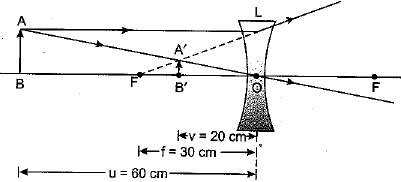
Q.27. (i) Identify any two parts from the above diagram which carry oxygenated and deoxygenated blood.
(ii) Explain the process of double circulation with the help of a flow chart. (5 Mark)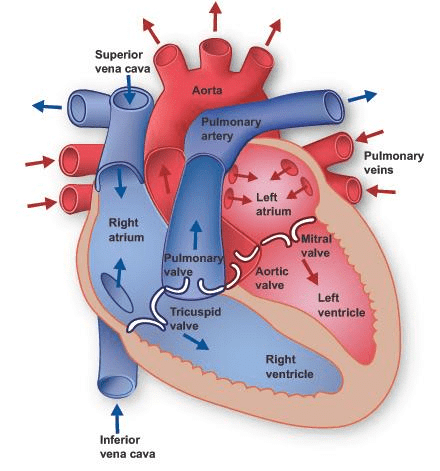 Ans: (i) Oxygenated: B/D/F [B = left ventricle/D=aorta/F=left auricle / pulmonary vein]
Ans: (i) Oxygenated: B/D/F [B = left ventricle/D=aorta/F=left auricle / pulmonary vein]
Deoxygenated : A/C/E [A= right ventricle/C= pulmonary artery/E=right auricle/vena cava]
(ii)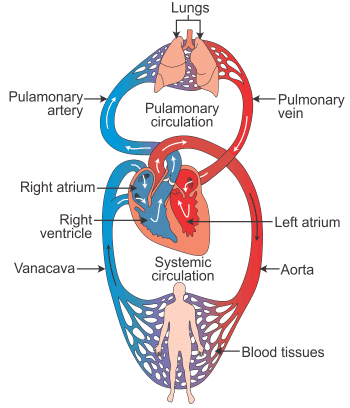 Fig: Double Circulation in Human BeingQ.28. (a) What are homologous structures? Give an example.
Fig: Double Circulation in Human BeingQ.28. (a) What are homologous structures? Give an example.
(b) "The sex of a newborn child is a matter of chance and none of the parents may be considered responsible for it." Justify this statement with the help of a flow chart showing sex-determination in human beings. (5 Mark)
Ans: (a) Homologous organs: Such organs which may have different functions but similar structure and origin. Example, fore arm of frog, lizard, bird and human.
(b) Sex of the child is a matter of chance. This is because females produce only one type of gamete - carry X chromosome. While males produce two types of gametes — 50% that carry X chromosome while 50% that carry Y chromosome.
It's a matter of chance as to which male gamete will fertilise the egg and decide the sex of the child.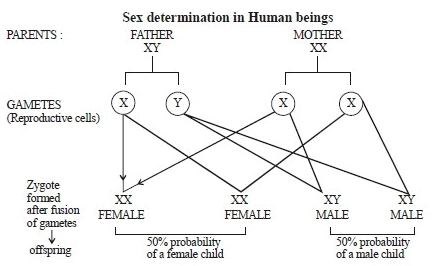 Hence, sex determination is purely a matter of chance.
Hence, sex determination is purely a matter of chance.
Q.29. (i) What is the far point and near point of the human eye with normal vision? (5 Mark)
(ii) How is the sense of vision carried from the eye to the brain?
(iii) Explain the cause and remedy of defect in eye with suitable diagram in which a person can see nearby objects clearly but cannot see distant objects clearly?
Or
(i) State two positions in which a concave mirror produces a magnified image of a given object. List two differences between the nature of these two images.
(ii) Differentiate between reflection and refraction of light.
(iii) A ray of light is incident on an imaginary surface separating diamond and water. Given that, the refractive index for diamond and water w.r.t. air are 2.42 and 1.33, respectively. Draw the diagram by showing refracted ray and mark angles of incidence and refraction.
Ans: (i) The far point and near point of the human eye with normal vision are infinity and least distance of distinct vision, i.e. 25 cm, respectively.
(ii) Sense of vision is carried by optic nerves from eye to the brain.
(iii) The defect in which a person can see nearby objects clearly but cannot see distant objects clearly, is called myopia or short-sightedness.
The causes and remedy of this defects are given below
Causes A person with this defect has the far point nearer than infinity. This defect arises due to the decrease in focal length of the eye lens because of
- excessive curvature of eye lens.
- elongation of the eyeball.
As a result, the image is formed before retina.
Remedy This defect can be corrected by using concave lens of appropriate power. A concave lens of suitable power will bring the image back on the retina, by diverging light rays initially, thus the defect is corrected as shown below Or
Or
(i) The two positions in which a concave mirror produces a magnified image are as follows:
(a) Between centre of curvature and focus of the mirror (real image).
(b) Between pole and focus of the mirror (virtual image).
Differences between real and virtual images are as follows:
Real Image
1. Real image can be obtained on the screen.
2. Real images are always inverted and are formed when light rays after reflection or refraction converge to a point.
Virtual Image
1. Virtual image cannot be obtained on the screen.
2. Virtual images are erect w.r.t object and are formed when rays after reflection appear to be coming from a point.
(ii) Differences between reflection and refraction are as follows:
Reflection
1. is the phenomena of bouncing back of light rays in the same medium on striking a smooth surface. e.g. Mirror
2. In this, the angle of incidence is equal to angle of reflection, i.e. ∠i = ∠r.
Refraction
1. It is the phenomena of change in path of a light as it passes from one medium to another medium. e.g. Glass slab
2. In this, the ratio of sine of angle of incidence to the sine of angle of refraction is a constant, for a light of given colour and for the given pair of media, i.e. sin i/ sin r = constant.
3. Given, μd =2.42 and μw = 1.33
As, μd >μw, this means light would travel from denser to rarer medium. Thus, it will bend away from normal (NN') as shown in the figure below: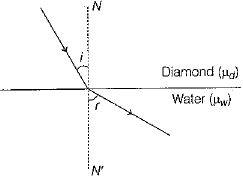
Q.30. (a) With the help of a suitable circuit diagram prove that the reciprocal of the equivalent resistance of a group of resistances joined in parallel is equal to the sum of the reciprocals of the individual resistances.
(b) In an electric circuit two resistors of 12 Ω each are joined in parallel to a 6 V battery. Find the current drawn from the battery.
Or
An electric lamp of resistance 20Ω and a conductor of resistance 4Ω are connected to a 6 V battery as shown in the circuit. Calculate : (5 Mark)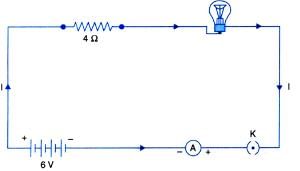 (a) the total resistance of the circuit,
(a) the total resistance of the circuit,
(b) the current through the circuit,
(c) the potential difference across the (i) electric lamp and (ii) conductor, and (d) power of the lamp.
Ans: (a) Circuit diagram of three resistances in a parallel grouping is shown here. Here one ends of all the resistances are joined at one point and the other ends of all the resistances are joined at another point. The cell providing current is joined across these two points.
It is obvious that, in parallel combination of three resistances R1, R2 and R3 the current in each of the three resistances is different. If I is the current drawn from the cell then it is divided into branches I1, I2 and I3. Thus, I = I1 + I2 + I3.
However, the potential difference across each of these resistances is the same as the voltage V of the cell.
Thus, from Ohm’s law 
If R is the equivalent resistance then,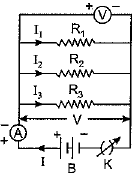

∴ 
and 
Thus, in parallel grouping reciprocal of the equivalent resistance is equal to the sum of the reciprocals of the individual resistances.
(b) Here resistances R1 = R2 =12Ω and voltage of battery V = 6 V
In parallel arrangement, total resistance Rp is given as:
⇒ Rp = 6Ω
∴ Current drawn 
Or
As per question the resistance of electric lamp = R1 = 20Ω, resistance of the conductor R2 = 4Ω and voltage of battery V = 6 V.
(a) Since bulb and conductor are joined in series, the total resistance of the circuit R = R1 + R2 = 20 + 4 = 24Ω.
(b) The current through the circuit 
(c) (i) Potential difference across the electric lamp 
(ii) Potential difference across the conductor 
(d) Power of the lamp 
|
80 videos|569 docs|80 tests
|
FAQs on Class 10 Science: CBSE Sample Question Paper (2019-20) - 1 - Science Class 10
| 1. What is the CBSE sample question paper for Class 10 Science? |  |
| 2. How can the CBSE sample question paper help in exam preparation? |  |
| 3. Is the CBSE sample question paper for Class 10 Science the same as the actual exam paper? |  |
| 4. Can the CBSE sample question paper help in scoring better marks in the exam? |  |
| 5. Where can I find the CBSE sample question paper for Class 10 Science? |  |

















